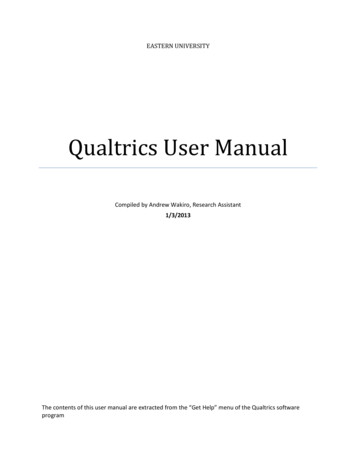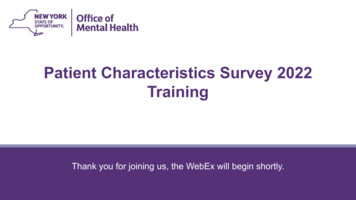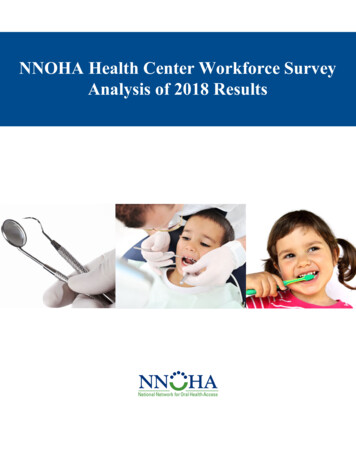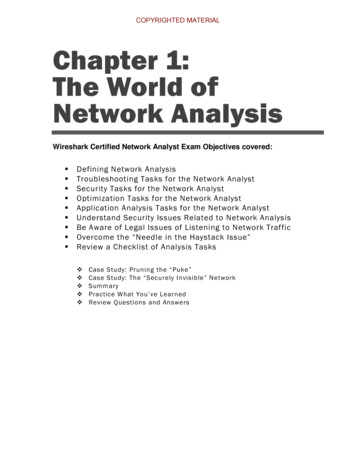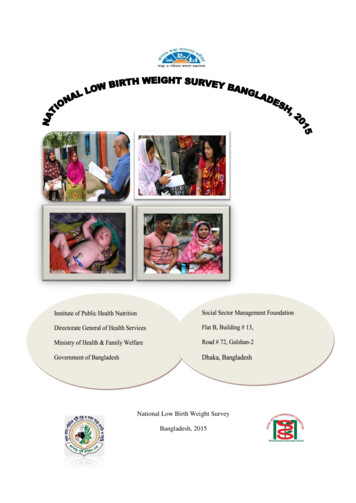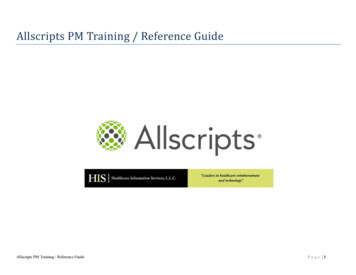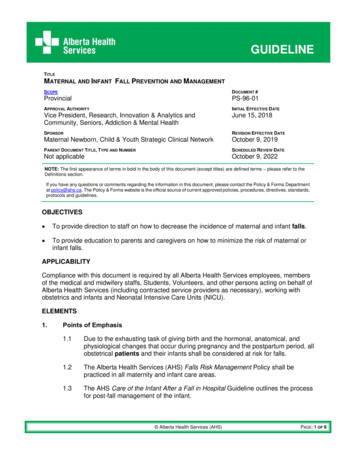
Transcription
NetworkPatientHealthSurvey2015
JUSTICE HEALTH & FORENSIC MENTAL HEALTH NETWORKABN 70 194 595 5061300 Anzac ParadeMalabar NSW 2036PO Box 150Matraville NSW 2036PhoneFax9700 30009700 3744Emailjhadmin@justicehealth.nsw.gov.auWebsite www.justicehealth.nsw.gov.auFor queries regarding the content of this report or for a copy of the survey instrument, please contact:Research and Evaluation ServiceJustice Health & Forensic Mental Health Network1300 Anzac ParadeMalabar NSW 2036PhoneEmail9700 3833RES@justicehealth.nsw.gov.auDesign:Print:Il RazzoCDM PrintCopyright 2017This work is copyright. It may be reproduced in whole or part for study or training purposes subject tothe inclusion of acknowledgement of the source. It may not be reproduced for commercial usage or sale.Reproduction for purposes other than those indicated above, require written permission from Justice Health& Forensic Mental Health Network.Disclaimer: Content within this publication was accurate at the time of publication. May 2017SHPN: (JH) 160526ISBNs 978-1-76000-568-9 (print)978-1-76000-569-6 (online)
2015 Network Patient HealthSurvey ReportJustice Health & Forensic Mental Health Network
Table of ContentsAbbreviations 5List of Tables and Figures 6Acknowledgements 10Foreword 11Executive Summary 12Introduction 15Methods 16Results 221. Social determinants 221.1Demographics 221.2Childhood care experiences 241.3Parents in prison or care 251.4Education 251.5Employment 271.6Pension or benefit 281.7Accommodation and living situation 291.8Children of participants 301.9Contact with family during incarceration 312. Offending behaviour 322.1Juvenile detention 322.2Previous incarceration 322.3Current incarceration 333. Health status 353.1Self‑reported health status 353.2Asthma 373.3Diabetes 383.4Vaccination and screening 393.5Men’s health 413.6Women’s health 41
3.7Access to healthcare 433.8Dental health 443.9Diet and nutrition 453.10 Disability and illness 473.11 Injury 493.12 Head Injury 504. Mental Health 524.1Psychiatric history 524.2Anxiety 544.3Depression 544.4Mania 554.5Psychosis 564.6Prodromal psychosis 574.7Personality disorder 574.8Post‑traumatic Stress 584.9Suicidal ideation and behaviour 604.10 Self‑harm 615. Alcohol Use and Drug Use 635.1Alcohol 635.2Drug Use and Treatment 636. Sexual Health 717. Tattooing and Piercing 748. Smoking 759. Physical health measures 789.1Height, Weight, and Body Mass Index (BMI) 789.2Vision 789.3Blood pressure 799.4Peak flow 799.5Blood borne viruses 809.6Sexually Transmissible Infections 81Key Findings and Policy Implications 82Reference List 85
AbbreviationsABSAustralian Bureau of StatisticsAH&MRCAboriginal Health and Medical Research CouncilAIHWAustralian Institute of Health and WelfareBHIBureau of Health InformationBMIBody Mass IndexBSEBreast Self-ExaminationCSNSWCorrective Services New South WalesHAVHepatitis A VirusHBVHepatitis B VirusHCVHepatitis C VirusHIVHuman Immunodeficiency VirusHRECHuman Research Ethics CommitteeJH&FMHN / the NetworkJustice Health & Forensic Mental Health NetworkNDIANational Disability Insurance AgencyNDISNational Disability Insurance SchemeNHMRCNational Health and Medical Research CouncilNHSNational Health SurveyNPHSNetwork Patient Health SurveyNRTNicotine Replacement TherapyNSPNeedle and Syringe ProgramNSWNew South WalesOSTOpioid Substitution TreatmentRESResearch and Evaluation ServiceSTISexually Transmitted InfectionTAFETechnical and Further EducationWHOWorld Health Organisation2015 NETWORK PATIENT HEALTH SURVEY REPORT5
List of Tables and FiguresTable 1Sampling targets by demographic group, NPHS 2015 18Table 2Target stratification of demographic groups, NPHS 2015 18Table 3Participants and proportion of target stratification achieved (%), NPHS 2015 19Table 4Number and response rate (%) of participants by demographic group and centre 19Table 5Weighing calculations for NPHS Sample 20Table 6Weighting of findings NPHS 2015 20Table 1.1.1Participant age by age groups. 22Figure 1.1.2Participants born outside Australia (percent by region of birth) 22Table 1.1.3Number of years in Australia (if born overseas) 23Figure 1.1.4Participants’ parents born overseas (percent by region of birth) 23Table 1.1.5Languages other than English spoken when growing up 23Table 1.1.6Legal relationship status 24Table 1.2.1Time spent in care before the age of 16 24Table 1.2.2Age first placed in care 25Table 1.2.3Type of care (if placed into care before age 16) 25Table 1.3.1Either or both parents ever incarcerated 25Table 1.3.2Parents ever placed into care during their childhood 25Figure 1.4.1Highest level of schooling 26Table 1.4.2Number of secondary schools attended 26Table 1.4.3Breakdown of post‑secondary and trade qualifications 26Table 1.4.4Courses undertaken 27Figure 1.4.5Courses undertaken by sex 27Table 1.5.1Employment 30 days before detention 27Figure 1.5.2Last job before incarceration (%) 28Figure 1.5.3Inmate employment in prison 28Table 1.6.1Pension or benefit type received 28Table 1.6.2Time spent on benefits or pension 29Table 1.7.1Accommodation six months prior to incarceration 29Table 1.7.2Number of moves in six months prior to incarceration 29Table 1.7.3People lived with prior to current incarceration 30Table 1.8.1Number of children under 16 years 30Table 1.8.2Number of dependent children living with participants 30Table 1.8.3Children’s current living situation 30Table 1.9.1Family visits to participants 31Figure 1.9.2Number of visits by mean travel time (hours) 31Table 1.9.3Letters of phone calls received 31Table 2.1.1Ever detained as a juvenile 32Table 2.1.2Number of times detained as a juvenile 32Table 2.2.1Previous incarceration history 32Table 2.2.2Age at first incarceration 3262015 NETWORK PATIENT HEALTH SURVEY REPORT
Table 2.2.3Number of times previously incarcerated 33Table 2.2.4Total time spent incarcerated 33Table 2.3.1Status current incarceration 33Table 2.3.2Amount of time served (current incarceration) at time of interview 33Table 2.3.3Number of inmates sharing cell 34Table 2.3.4Security classification 34Table 2.3.5Most serious current offence 34Table 3.1.1Self‑assessment of physical health 35Table 3.1.2Ever diagnosed with health condition 35Figure 3.1.3Comparison of NPHS 2015 figures with National Health Survey 2012 36Table 3.1.4Number of self‑reported health problems 36Figure 3.1.5Number of health conditions NPHS 2015 and NHS 2012 37Table 3.1.6Still have health condition 37Table 3.2.1Asthma attacks and difficulties breathing in past 3 months 37Figure 3.2.2Inclusions in Asthma Management Plan 38Table 3.2.3Frequency of use for primary and secondary medication 38Figure 3.3.1Location of previous blood sugar tests 39Figure 3.3.2Measures to manage diabetes 39Table 3.4.1History of vaccination against specific infections 40Table 3.4.2Screening for STI and bowel cancer 40Table 3.5.1Regularity of testicle examination 41Figure 3.6.1Frequency of BSE (%) 41Figure 3.6.2History of Pap smear testing (%) 42Figure 3.6.3Results of last Pap smear test 42Table 3.6.4Number of pregnancies 42Table 3.6.5Number of births including still born 42Table 3.6.6Termination history 43Table 3.7.1Last accessed healthcare while in custody 43Table 3.7.2Willingness to access healthcare in the future 43Table 3.7.3Health professionals accessed in 12 months preceding interview 43Table 3.7.4Admission to hospital in previous 12 months 44Table 3.8.1Teeth or gum problems in last 12 months 44Table 3.8.2Dental treatments in the past 12 months 45Table 3.8.3Time since last dental treatment 45Table 3.8.4Reason for not receiving dental treatment in last 12 months 45Table 3.9.1Consumption of fruit and vegetables 46Table 3.9.2Reasons for not consuming sufficient fruit and vegetables 46Table 3.9.3Food items purchased through buy‑ups 46Table 3.10.1Age and sex breakdown of participants reporting a disability 47Figure 3.10.2NDIA assessment of impact of disability or chronic illness for participants identified with a disability 482015 NETWORK PATIENT HEALTH SURVEY REPORT7
Table 3.10.3NDIA assessment of impact of disability or chronic illness by sex 48Table 3.11.1Injuries sustained in the last 12 months 49Table 3.11.2Cause of reported injuries 49Table 3.11.3Place of injury 49Table 3.11.4Activity during which injury occurred 50Table 3.11.5Severity of injury 50Table 3.11.6Action taken as a result of injury 50Table 3.12.1Number of head injuries among participants reporting at least one 50Table 3.12.2Cause of head injury 50Table 3.12.3Length of time since head injury 51Table 3.12.4Time unconscious 51Table 3.12.5Current effects of head injury 51Table 4.1.1Time from contact with mental health professional and incarceration 52Table 4.1.2Ever received a diagnosis for mental health condition 53Table 4.1.3Age first diagnosed 53Table 4.1.4Where was diagnosis made 53Table 4.1.5Time since contact with mental health profession in prison 53Table 4.1.6Self‑reported mental health 54Table 4.2.1Anxiety measured by GAD‑7 54Table 4.3.1Depression measured by PHQ‑9 based on symptoms experienced two weeks prior to interview 55Table 4.3.2Impact of symptoms of depression 55Table 4.4.1Lifetime prevalence of mania symptoms 56Figure 4.4.2Current prevalence of symptoms of a manic episode for those indicating lifetime prevalence (%) 56Table 4.5.1Lifetime prevalence of positive screens for psychosis 57Table 4.5.2Psychosis symptoms in two weeks prior to interview for those with lifetime prevalence 57Table 4.8.1Types of traumatic event experienced 58Table 4.8.2Lifetime prevalence of PTSD symptom clusters in participants with a history of traumatic events 59Table 4.8.3Proportion of participants who experienced a traumatic event who meet diagnostic criteria forPTSD symptom clusters 59Table 4.8.4Number of symptom clusters present 59Table 4.9.1Time since last thoughts of suicide among those with lifetime prevalence 60Table 4.9.2Regularity of suicidal thoughts among those with lifetime prevalence 60Table 4.9.3Number of suicide attempts for participants with one or more attempt 60Table 4.9.4Method of suicide attempt 60Table 4.9.5Likelihood of attempting suicide while in prison 61Table 4.10.1Number of self‑harm episodes among those with lifetime prevalence 61Table 4.10.2Method of self‑harm for those with history of self‑harming behaviour 61Table 4.10.3Reasons for self‑harm 62Table 4.10.4Time since last self‑harm incident 62Table 5.1.1Family members with a history of alcohol-related problems 6382015 NETWORK PATIENT HEALTH SURVEY REPORT
Table 5.2.1Substances taken prior to offending 64Table 5.2.2Ever used drugs 64Table 5.2.3Proportion of drug users who used daily or almost daily 65Table 5.2.4Drug use in prison 65Table 5.2.5Drug use in the past four weeks 66Table 5.2.6Proportion of drug users who have ever injected 66Table 5.2.7Ever injected in prison as a proportion of whole sample 67Table 5.2.8Assistance received after overdosing in prison 67Table 5.2.9Time since last injecting drugs 67Table 5.2.10Use of new sterile needles in month prior to incarceration 68Table 5.2.11Main source of injecting equipment in 12 months prior to incarceration 68Table 5.2.12Disposal of used injecting equipment 68Table 5.2.13Understanding of importance of safe injecting and willingness to use safe equipment 69Table 5.2.14Sought treatment for which substances 69Table 5.2.15Where drug treatment was sought from 69Table 5.2.16Use of OST 70Table 5.2.17Drugs participants currently require assistance quitting 70Table 6.1.1Age at first consensual sex 71Table 6.1.2Sexuality of participants 71Table 6.1.3Number and gender of sexual partners in previous 12 months 71Table 6.1.4Total number of sexual partners 71Table 6.1.5Reasons provided for failing to engage in safer sex practices 72Table 6.1.6Diagnoses for those who had been diagnosed with a STI 72Table 6.1.7Experiences of sexual violence 72Table 6.1.8Time since most recent sexual assault aware of 73Table 7.1.1Tattoos and piercings 74Table 8.1.1Time to first cigarette 75Table 8.1.2Number of cigarettes smoked per day 75Table 8.1.3Awareness of smoking cessation services among smoking participants 76Table 8.1.4Time since last quit attempt in prison 76Table 8.1.5Use of smoking cessation services 76Table 8.1.6How often do you smell second hand cigarette smoke? 76Table 8.1.7How did you first hear that smoking is being banned 77Table 8.1.8Response to the introduction of the smoke free policy 77Table 9.1.1Participant weight categories based on BMI 78Table 9.1.2Health risk based on waist measurement categorisation 78Table 9.2.1Visual acuity 79Table 9.3.1Blood pressure categories 79Table 9.4.1Peak flow results 792015 NETWORK PATIENT HEALTH SURVEY REPORT9
AcknowledgementsWe are indebted to the following individuals and organisations for their support, input, and assistancein the development and implementation of the 2015 Network Patient Health Survey (NPHS) and thepreparation of this report. Operational support: Julie Babineau, Gary Forrest, Geraldine Baillet, Alicia Webster, Dr Stephen Hampton, Jenny Douglas,Joanne Hunnisett, Vicki Archer, Jason Boyd from the Bureau of Health Information (BHI), members of the NPHS SteeringCommittee and the Aboriginal Reference Group, and all Justice Health & Forensic Mental Health Network (JH&FMHN) NurseManagers and Nursing Unit Managers for supporting the research team. Data collectors: Adriane Carter, Amy Laxton, Andrew Wong, Angela Wilkinson, Anselle Realista, Ashleigh Cussen, AudreyLazaris, Brijesh Aryal, Carly Stanley, Diane Broomhall, Eleanor Reed, Evan Freeman, Gillian Lambert, Jean Harwood,Kathleen Herbert, Kelly Hodson, Kylee Wilson, Martha Marangi, Mary Fitzsimons, Maxwell Mutakiwa, Michelle Lawrence,Natalie Ricks, Nicole Ang, Phillipa Affleck, Prabin Chemjong, Rhonda Halpin, Sharon Jacobs, Sonya Edenden, TemptationGahadza, Vicki Wicks, Vicki Douglas, Weller Zheng. Investigators: I ncluding Associate Professor Kimberlie Dean, Dr Courtney Field, Dr Julia Bowman, Dr Daria Korobanova,Amy Lewandowski and Brendan Christie. Corrective Services NSW: Peter Severin, Adam Schreiber and all the CSNSW General Managers, Managers of Securityand their staff on the ground for assisting in the coordination and implementation of the survey. Participants: M ost importantly, we gratefully acknowledge the inmates of New South Wales Correctional Centres whoparticipated in the NPHS and without whom the Survey would not have been possible.102015 NETWORK PATIENT HEALTH SURVEY REPORT
ForewordThe Justice Health & Forensic Mental Health Network has demonstrated itself to be a leader in the implementation of evidence-basedhealth service provision. Key to this responsibility is the Network’s commitment to undertake a comprehensive epidemiologicalsnapshot of prisoner health at approximately five yearly intervals. The current report presents results from data collected in 2015and represents the fourth iteration of the Survey over a twenty-year history. This is a remarkable achievement for the Network andconstitutes a singular contribution to the broader public health sector, both here in Australia and internationally. As the Network’srange of services and expertise have expanded rapidly over the last two decades to meet the diverse needs of our patient cohort,so the NPHS (previously, the Inmate Health Survey) has developed in complexity and rigour through each iteration.The Network’s vision and values motivate its committed and dedicated staff to use the best and most relevant evidence to informthe provision of health care to our patients. This imperative led to the establishment in 2003 of what is now known as the Network’sResearch and Evaluation Service (RES) (the Centre for Health Research in Criminal Justice prior to 2015). As part of the NPHS,the Network has established a number of mutually advantageous partnerships with academic and professional institutions whichcontinue to inform and support the Network’s research activities. On behalf of the Board, the Network Executive, and its staff, weextend our sincere thanks to these valuable partners and look forward to our continuing collaboration.The 2015 NPHS has benefited from a number of methodological improvements, particularly with regards to sampling strategy.Despite these changes, this survey broadly confirms previous findings. It is perhaps unsurprising for those accustomed to theneeds of the custodial and forensic mental health patient populations in NSW to see that mental health problems, drug andalcohol use and dependence, and chronic disease are all highly prevalent. Undertaken just prior to the introduction of the StateGovernment’s smoke-free correctional centre policy in all NSW correctional facilities, data presented here provides a strongjustification for prohibiting smoking in custody which was primarily driven as a work, health and safety initiative to protect ourstaff but also as a major public health intervention, where smoking rates were significantly high at 80.7% among men and89.1% among women. The burden of disease caused by smoking is well established and the next survey will provide a uniqueopportunity to examine the change in a range of smoking-related harms five years after the policy’s implementation.Providing quality care to our patients remains the Network’s main priority. With many having minimal contact with mainstreamhealth services in the community, the Network recognises the important role it has to address their health needs, and theopportunity this presents to improve the wellbeing of the patient, their families, carers and the wider community. Resultspresented in this report provide a firm base to inform policy and practice, allowing the Network to continue to deliver improvedhealth outcomes for patients in custody in NSW.In addition to this report on adults in custody, three other reports are forthcoming. Once again, the Network is undertaking aseparate report which contrasts the differing needs of Aboriginal and non-Aboriginal patients, as well as a report on youngpeople in custody. For the first time, the Network has also collected data from forensic mental health patients under the Network’scare and will be compiling a separate report on these patients. JH&FMHN is sure that these publications, as well as discreteanalyses utilising NPHS data, will provide sound evidence to guide the Network and make a valuable contribution to the broadercriminal justice system, forensic mental health network and public health sector.Christopher Puplick AMGary ForrestBoard ChairChief Executive2015 NETWORK PATIENT HEALTH SURVEY REPORT11
Executive SummaryIntroductionBackgroundThe Justice Health & Forensic Mental Health Network’scommitment to carrying out a large-scale epidemiologicalexamination of inmate health began in 1996 (Butler, 1996) andwas repeated in 2001 (Butler & Milner, 2003), and 2009 (Indig,et al., 2009). The current report represents the latest updatein a series of research spanning two decades. This corpusof work has been undertaken under the auspices of RESand is recognised internationally as the most comprehensiveexamination of inmate health undertaken within a singlejurisdiction. Data from each of these surveys has alsoinformed the publication of numerous peer-reviewed articlesacross a broad spectrum of topics including: Aboriginaland Torres Strait Islander health, intellectual disability, drugand alcohol use, access to health services, smoking, andoral health. RES staff members are already in the processof planning a new tranche of publications which illuminatepriority areas identified by the Network’s Board. In theseways the NPHS provides a valuable evidence-base whichinforms service planning and the delivery of care to patientsin a manner that optimises the Network’s available resources.The Network is responsible for providing health care to adultsand juveniles in the criminal justice system across four keyareas:In light of these considerations, the Network was committedto providing funding to RES to undertake the 2015 NPHS.This survey replicates previous ones in many respects,but has been subject to considerable improvements inmethodological rigour and content development. In particular,revisions to the sampling strategy for the survey provide fora more strongly representative sample than has been seenin previous iterations without compromising comparisonsbetween key subgroups in the population. A much expandedmental health section, and an examination of the impact ofdisability which more fully assesses the current needs ofpatients, are also improvements of note.This report was based on responses from 1,131participants. Results are presented separately for menand women. A separate report will examine differencesbetween Aboriginal and non-Aboriginal participants. Due tochanges in sampling strategy, direct comparison betweenresults presented here and previous surveys is not possible.This is an unfortunate consequence of a methodologicalimprovement that is believed to be necessary to guaranteethe survey’s utility moving forward.12In July 2015, the NSW adult prison population stood in excessof 11,600 and was 18% greater than when sampling occurredfor the previous survey (Indig, et al., 2009). Despite makingup approximately 3% of the Australian population, and 2.9%of the NSW population (Australian Bureau of Statistics [ABS],2011), Aboriginal and Torres Strait Islander people accountedfor 24.2% of the NSW prison population in July 2015, anincrease of 2.5% since 2009. Pre-custody: i ncluding diversion for people with mentalillness in the adult or juvenile court system away fromcustody into appropriate treatment, including the CourtLiaison Service, the Adolescent Community and CourtTeam and the Adult Drug Court. Custody: f or adult prisoners (in 36 correctional centres)and juvenile detainees (in 7 juvenile justice centres and1 juvenile detention centre), periodic detainees (11centres), and police cell complexes (7 centres). Thecare provided includes screening, triage, treatmentand monitoring in areas such as clinical and nursingservices, primary health, population health, drugand alcohol, women’s health, Aboriginal health, andadolescent health. Inpatient: inpatient healthcare services including theLong Bay and Forensic Hospitals, as well as organisinginpatient and specialist care in community-basedhospitals for people in custody. Post-release: i ncluding community forensic mentalhealth (for adults), Community Integration Team (foryoung people) and the Connections Project whichassists in integrating people with a drug and alcoholproblem into community based services.In light of the model described above, the health issuesidentified in this report cannot be solved or improved bythe Network alone. The Network’s primary focus remains onscreening, assessment and referral and release planning.Partnerships with the criminal justice system and healthservices in the community remain critical to improving thehealth status of the inmate population in NSW.2015 NETWORK PATIENT HEALTH SURVEY REPORT
MethodologyThe survey was conducted using a stratified random sampleof all inmates across NSW. A total of 1,493 adult prisoners wasinvited to take part in the 2015 NPHS, of which 1,132 (76%)agreed. This included 1,066 randomly selected participantsand 65 patients targeted because they had completed aprevious survey. Targets were set for recruitment relatingto gender and ethnicity (Aboriginal or non-Aboriginal).Only one individual reported that they were transgenderedor transitioning. Due to concerns that separate analysis ofthis person’s data may lead to their identification, they wereremoved from analysis. The sample was also stratified bybroad age groupings (18-24 years, 25-44 years, 45 yearsor more) to ensure the sample accurately reflected the ageprofile of the prison population.As in 2009, key demographic groups, Aboriginal peopleand women, were over sampled to ensure better estimatesof health issues for these populations however results wereweighted to account for this over sampling in analysis. Thisensures results that can be taken as indicators of populationprevalence within accepted confidence levels. In 2009 thequestionnaire component of the survey was undertaken usingComputer Assisted Telephone Interviewing technology; 2015saw a return to face-to-face interviews as a more prudentexpenditure of resources.Key FindingsSocial Determinants The median age of participants was 35 years. 14.3% reported they had been placed in care at sometime before age 16. Nearly one in five participants reported that either orboth their parents had been incarcerated during theirchildhood. Few participants (0.7%) had never been to school but72.1% had left school by the end of year 10. 11.5% had some difficulties with reading and writingwith a further 2.6% indicating they could not read orwrite at all.2015 NETWORK PATIENT HEALTH SURVEY REPORT In the thirty days prior to incarceration only 46.8% ofparticipants were employed; 38.8% were unemployed;and 13.3% were unable to work. 9.7% were homeless or in unsettled accommodationprior to incarceration while the ABS reports the rate inthe community at 0.5%.Offending behaviour Almost one third (32.5%) had been detained as ajuvenile. A higher proportion of men (33.4%) reportedthis than women (20%). 60.3% had been incarcerated in an adult facility prior totheir current sentence. A smaller proportion of women(52.6%) reported this than men (60.9%). 77.2% were currently serving a sentence and 22.8%were on remand.Health Status 30.6% of participants rated their health as ‘very good’or ‘excellent’. A smaller proportion of women (26.3%)reported this than men (30.9%). The top five health problems reported were:back problems (23.5%), hepatitis C (20.7%), asthma(20.6%), allergies (19.4%), hypertension (15.6%).These rates are much higher in comparison to the widercommunity. There was a higher prevalence of most conditionsamong females compared to males. 24.3% had never been diagnosed with a medicalcondition. 92.2% of women had previous undergone a Pap smeartest, with 72.8% of these women having had their lasttest within two years before being interviewed.Access to Healthcare 17.5% of participants said that they had not accessedhealthcare services in prison or had only done so onentering custody. 53.8% said that they would access healthcare servicesfor any health problem that concerned them. In prison, participants were most likely to have seen anurse (82%) or a general practitioner (56%).13
Smoking, Alcohol and Other DrugsMental Health The vast majority of participants (85.7%) reportedthat they were smokers. In accordance with NSWGovernment policy, smoking was banned at all sites inAugust 2015. 49.2% of participants had received some formof psychiatric care prior to their current period ofincarceration. A higher proportion of women (54.9%)reported this compared to men (48.8%). 82.1% of smokers felt they were addicted to smokinghowever the majority (69.4%) reported that they did notintend to smoke once they were released back into thecommunity. 62.9% of participants had received at least one mentalhealth diagnosis including 48.1% of those who reportedno previous contact with a mental health clinician. There was a large number of participants who reporteddrinking at levels considered hazardous. 67.1% of menand 63.3% of women scored above 8 (indicative ofhazardous drinking). 13% had been diagnosed with an alcohol use disorder.The most common diagnoses were: depression (38.1%)and anxiety (24.9%). Clear differences between sexeswere observed for each of these. While 61.2% of womenhad been diagnosed with depression, 36.4% of menhad and while 51% of women had been diagnosed withanxiety, 23% of men had. Almost all participants (85.7%) reported having misuseddrugs other than alcohol. A slightly higher proportion ofmen (85.8%) reported this compared to women (84.7%). Cannabis was the most common drug ever used (81.7%),followed by methamphetamine (66.8%), amphetamines(57.4%), and cocaine (50.5%). While direct comparisonto previous surveys is not possible in this report, itis nonetheless interesting to compare the use of ice(crystalline methamphetamine) in 2015 with result from2001, when only 11% reported having used it, through 2009when 42% had used it. Methodological enhancementscannot explain a rise in use exceeding 24%.Almost one third (30.5%) of participants reportedhaving contemplated suicide at some stage in their lives.A higher proportion of women (43.3%) reported thiscompared to men (29.6%). More than two thirds (67.7%)of these individuals had experienced suicidal ideationwithin the 12 months prior to being interviewed. 17.8% of all participants had attempted suicide at leastonce. This included 17% of men and 28.6% of women. 11.8% reported having engaged in self-harm behaviours.A higher proportion of women (24.6%) reported thiscompared to men (10.9%). 1463.2% of methamphetamine users reported having usedon a daily or almost daily basis prior to incarceration. Inaddition, 57% of cannabis users, 28.7% of amphetamineusers and 21.7% of cocaine users reported daily oralmost daily use.ConclusionsThe 2015 NPHS confirms that the prison populationpresents with a complex and diverse health profile. Whilethe correctional environment is restrictive in many respects,it provides a unique opportunity to address the needs ofa vulnerable population who may not otherwise have theirchronic health needs assessed. Results from this surveyhave an important role to play in the planning and delivery ofservices to meet these needs; ensuring that limited resourcesare targeted to ensure optimum outcomes.2015 NETWORK PATIENT HEALTH SURVEY REPORT
IntroductionA sentence of imprisonment ought not to be considered asentence of ill-health, and the state bears a responsibilityto provide appropriate care and treatment to sick peoplewho, through the deprivation of their liberty, have also beendeprive
3.9 Diet and nutrition 45 3.10 Disability and illness 47 3.11 Injury 49 3.12 Head Injury 50 4. Mental Health 52 4.1chiatric history Psy 52 4.2 Anxiety 54 4.3 Depression 54 4.4 Mania 55 4.5 Psychosis 56 4.6 Prodromal psychosis 57 4.7ersonality disorder P 57 4.8ost‑traumatic Stress P 58 4.9 Suicidal ideation and behaviour 60
